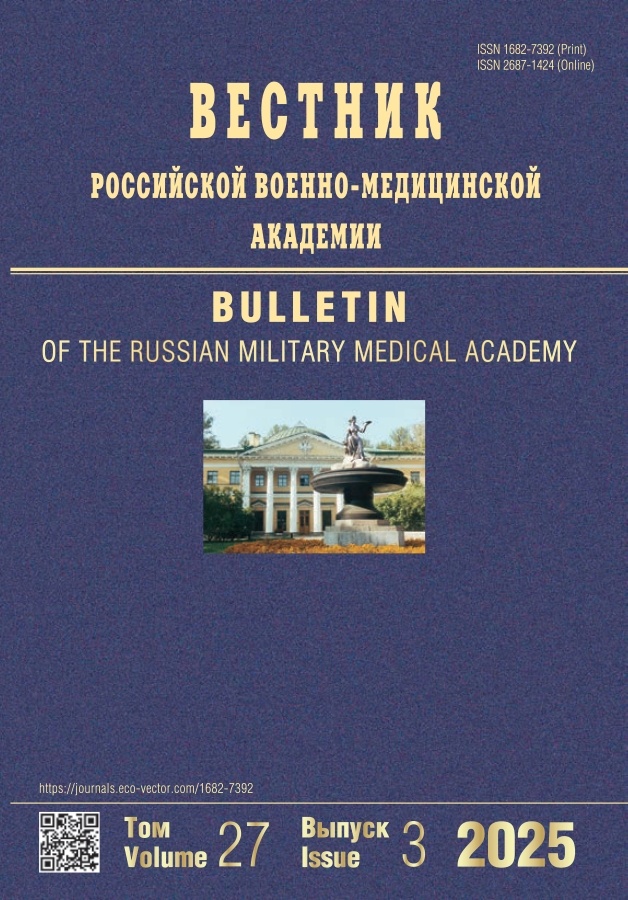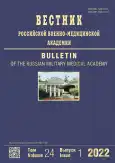Use of a local hemostatic agent based on chitosan and external compression of the abdominal area to control intra-abdominal bleeding
- 作者: Golovko K.P.1,2, Samokhvalov I.M.1, Grishin M.S.1, Nosov A.M.1, Yudin A.B.3, Kovalevsky A.Y.1, Bagnenko A.S.1,2, Kovalishin I.M.2
-
隶属关系:
- Military medical academy of S.M. Kirov
- Saint Petersburg State University
- State Research Testing Institute of Military Medicine
- 期: 卷 24, 编号 1 (2022)
- 页面: 43-54
- 栏目: Original Study Article
- URL: https://journals.rcsi.science/1682-7392/article/view/91155
- DOI: https://doi.org/10.17816/brmma91155
- ID: 91155
如何引用文章
详细
The paper presents the intermediate results of an experimental study of three samples of chitosan-based local hemostatic agent in a model of intense intra-abdominal bleeding in an average-sized experimental animal (a Soviet Chinchilla rabbit) with a standard wound on the parenchymal organ (liver) in combination with external compression of the abdominal area to achieve hemostasis in the acute phase of the experiment. At the first stage, nine experimental groups and one control group, with three biological objects each, were involved (n = 30). The composition and properties of laboratory preparations of hemostatics were different from the concentration of the main component. To select the optimal sample of a local hemostatic agent with the least local irritant effect on the organs and structures of the abdominal cavity, three experimental groups with three animals each were formed at the second stage, without modeling blood loss (n = 9) with follow-up from 24 to 72 h. The studied drugs have high hemostatic activity in the model of intense intra-abdominal bleeding with follow-up periods from several hours to 3 days. Moreover, intraperitoneal administration of hemostatic agent samples does not lead to a pronounced local irritant effect. However, during the first 180 min of the experiment, only one fatal outcome was recorded in a group of animals with 15% chitosan in the studied drug because of a technical error in modeling the source of bleeding. External compression of the abdominal area demonstrated its effectiveness as an auxiliary technique for temporary control of the intra-abdominal source of bleeding in the experimental model. The objectification of the obtained results was achieved through a control sectional study and laboratory screening of peripheral blood indicators of experimental animals at different stages of the experiment. To further evaluate the hemostatic activity of chitosan-based drugs, creating an experimental model using a large experimental animal is necessary.
作者简介
Konstantin Golovko
Military medical academy of S.M. Kirov; Saint Petersburg State University
编辑信件的主要联系方式.
Email: vmeda-nio@mail.ru
ORCID iD: 0000-0002-1584-1748
SPIN 代码: 2299-6153
doctor of medical sciences, associate professor
俄罗斯联邦, Saint Petersburg; Saint PetersburgIgor Samokhvalov
Military medical academy of S.M. Kirov
Email: igor-samokhvalov@mail.ru
SPIN 代码: 4590-8088
doctor of medical sciences, professor
俄罗斯联邦, Saint PetersburgMaxim Grishin
Military medical academy of S.M. Kirov
Email: al13max@mail.ru
ORCID iD: 0000-0003-0846-3432
SPIN 代码: 8766-2055
adjunct
俄罗斯联邦, Saint PetersburgArtem Nosov
Military medical academy of S.M. Kirov
Email: artem_svu06@mail.ru
ORCID iD: 0000-0001-9977-6543
SPIN 代码: 7386-3225
candidate of medical sciences
俄罗斯联邦, Saint PetersburgAndrey Yudin
State Research Testing Institute of Military Medicine
Email: yudin_a73@mail.ru
SPIN 代码: 7060-1221
candidate of medical sciences
俄罗斯联邦, Saint PetersburgArkady Kovalevsky
Military medical academy of S.M. Kirov
Email: kovalevskiy.arkadiy@mail.ru
SPIN 代码: 1630-7857
student
俄罗斯联邦, Saint PetersburgAndrey Bagnenko
Military medical academy of S.M. Kirov; Saint Petersburg State University
Email: BagnenkoA.S.MFS@mail.ru
ORCID iD: 0000-0002-9293-4390
SPIN 代码: 4360-6869
candidate of medical sciences
俄罗斯联邦, Saint Petersburg; Saint PetersburgIvan Kovalishin
Saint Petersburg State University
Email: ikovalishin52@gmail.com
ultrasound diagnostics doctor
俄罗斯联邦, Saint Petersburg参考
- Velichko MA, Yudin VI, Krasikov EK. Struktura bezvozvratnykh poter’ v sovremennykh vooruzhennykh konfliktakh. Military Vedical Journal. 1997;318(1):64–68. (In Russ.).
- Maughon JS. An inquiry into the nature of wounds resulting in killed in action in Vietnam. Military Medicine. 1970;135(1):8–13. doi: 10.1093/milmed/135.1.8
- Trishkin DV, Fisun AYa, Kryukov EV, Vertii BD. Voennaya meditsina i sovremennye voiny: opyt istorii i prognozy, chto zhdat’ i k chemu gotovit’sya. Sbornik statei III Vserossiiskoi nauchno-tekhnicheskoi konferentsii. 2021 May 27–28. Anapa. P. 8–16. (In Russ.).
- Samokhvalov IM, Kryukov EV, Markevich VYu, et al. Military field surgery in 2031. Military Medical Journal. 2021;342(9):4–11. (In Russ.). doi: 10.52424/00269050_2021_342_9_04
- Kotiv BN, Samokhvalov IM, Badalov VI, et al. Battle-field surgery in the beginning of 21st century. Military Medical Journal. 2016;337(5):4–10. (In Russ.).
- Palm K, Apodaca A, Spencer D, et al. Evaluation of military trauma system practices related to damage-control resuscitation. J Trauma Acute Care Surg. 2012;73(6):459–464. doi: 10.1097/TA.0b013e3182754887
- Hoencamp R, Vermetten E, Tan ECTH, et al. Systematic review of the prevalence and characteristics of battle casualties from NATO coalition forces in Iraq and Afghanistan. Injury. 2014;45(7): 1028–1034. doi: 10.1016/j.injury.2014.02.012
- Blackbourne LH, Baer DG, Eastridge BJ, et al. Military medical revolution: prehospital combat casualty care. J Trauma Acute Care Surg. 2012;73(6):372–373. doi: 10.1097/TA.0b013e31827556
- Bisenkov LN, Zubarev PN, Trofimov VM, et al. Neotlozhnaya khirurgiya grudi i zhivota: rukovodstvo dlya vrachei. Saint Petersburg: Gippokrat; 2002. 510 p. (In Russ.).
- Savel’ev VS. Rukovodstvo po neotlozhnoi khirurgii organov bryushnoi polosti. Moscow: Triada X; 2004. 640 p. (In Russ.).
- Singh KJ, Galagali A. Abdominal Trauma in Combat. Med J Armed Forces India. 2010;66(4):333–337. doi: 10.1016/S0377-1237(10)80011-5
- Lewis KM, Li Q, Jones DS, et al. Development and validation of an intraoperative bleeding severity scale for use in clinical studies of hemostatic agents. Surgery. 2017;161(3):771–781. doi: 10.1016/j.surg.2016.09. 022
- Adams D, McDonald PL, Sullo E, et al. Management of non-compressible torso hemorrhage of the abdomen in civilian and military austere/remote environments: protocol for a scoping review. Trauma Surg Acute Care Open. 2021;6(1):e000811. doi: 10.1136/tsaco-2021-000811
- Maddry JK, Perez CA, Mora AG, et al. Impact of prehospital medical evacuation (MEDEVAC) transport time on combat mortality in patients with non-compressible torso injury and traumatic amputations: a retrospective study. Military Med Res. 2018;5(1):22. doi: 10.1186/s40779-018-0169-2
- Keenan S, Riesberg JC. Prolonged Field Care: Beyond the “Golden Hour”. Wilderness and Environmental Medicine. 2017;28(2S): 135–139. doi: 10.1016/j.wem.2017.02.001
- Riesberg J, Powell D, Loos P. The loss of the golden hour. Medical Support for the Next Generation of Military Operations Special Warfare. Fort Bragg. 2017;30(1):49–51.
- Duggan M, Rago A, Sharma U, et al. Self-expanding polyurethane polymer improves survival in a model of noncompressible massive abdominal hemorrhage. J Trauma Acute Care Surg. 2013;74(6):1462–1467. doi: 10.1097/TA.0b013e31828da937
- Rago AP, Duggan MJ, Beagle J, et al. Self-expanding foam for prehospital treatment of intra-abdominal hemorrhage: 28-day survival and safety. J Trauma Acute Care Surg. 2014;77(3):127–133. doi: 10.1097/TA.0000000000000380
- Peev MP, Rago A, Hwabejire JO, et al. Self-expanding foam for prehospital treatment of severe intra-abdominal hemorrhage: dose-finding study. J Trauma Acute Care Surg. 2014;76(3):619–624. doi: 10.1097/TA.0000000000000126
- Rago AP, Duggan MJ, Hannett P, et al. Chronic safety assessment of hemostatic self-expanding foam: 90-day survival study and intramuscular biocompatibility. J Trauma Acute Care Surg. 2015;79(4):78–84. doi: 10.1097/TA.0000000000000571
- Rago AP, Marini J, Duggan MJ, et al. Diagnosis and deployment of a self-expanding foam for abdominal exsanguination: Translational questions for human use. J Trauma Acute Care Surg. 2015;78(3): 607–613. doi: 10.1097/TA.0000000000000558
- Berwick RJ, Gauntlett W, Silverio SA, et al. A mixed-methods pilot study to evaluate a collaborative anaesthetic and surgical training package for emergency surgical cricothyroidotomy. Anaesth Intensive Care. 2019;1:1–11. doi: 10.1177/0310057X19861978
- Inaba K, Branco BC, Rhee P, et al. Long-term preclinical evaluation of the intracorporeal use of advanced local hemostatics in a damage-control swine model of grade IV liver injury. J Trauma Acute Care Surg. 2013;74(2):538–545. doi: 10.1097/TA.0b013e31827d5f5f
- Logun MT, Dowling MB, Raghavan SR, et al. Expanding Hydrophobically Modified Chitosan Foam for Internal Surgical Hemostasis: Safety Evaluation in a Murine Model. J Surg Res. 2019;239:269–277. doi: 10.1016/j.jss.2019.01.060
- Qin H, Yang L, Liu D, et al. Efficacy of a Temporary Hemostatic Device in a Swine Model of Closed, Lethal Liver Injury. Military Medicine. 2020;185(5):742–747. doi: 10.1093/milmed/usz3722
补充文件








